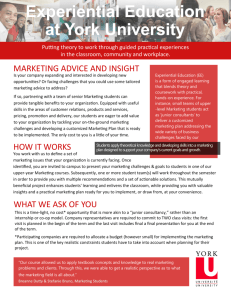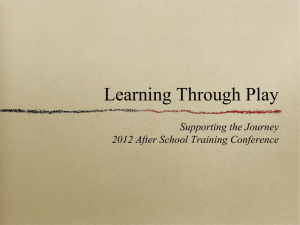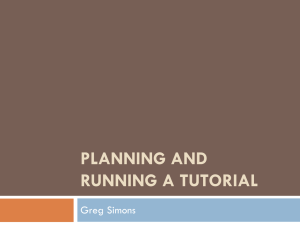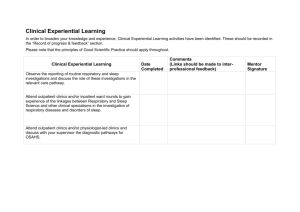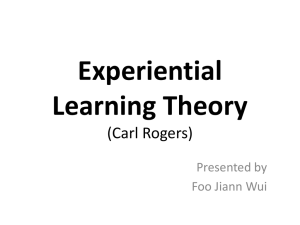Louisa Dubery Paper - The Association of Law Teachers
advertisement
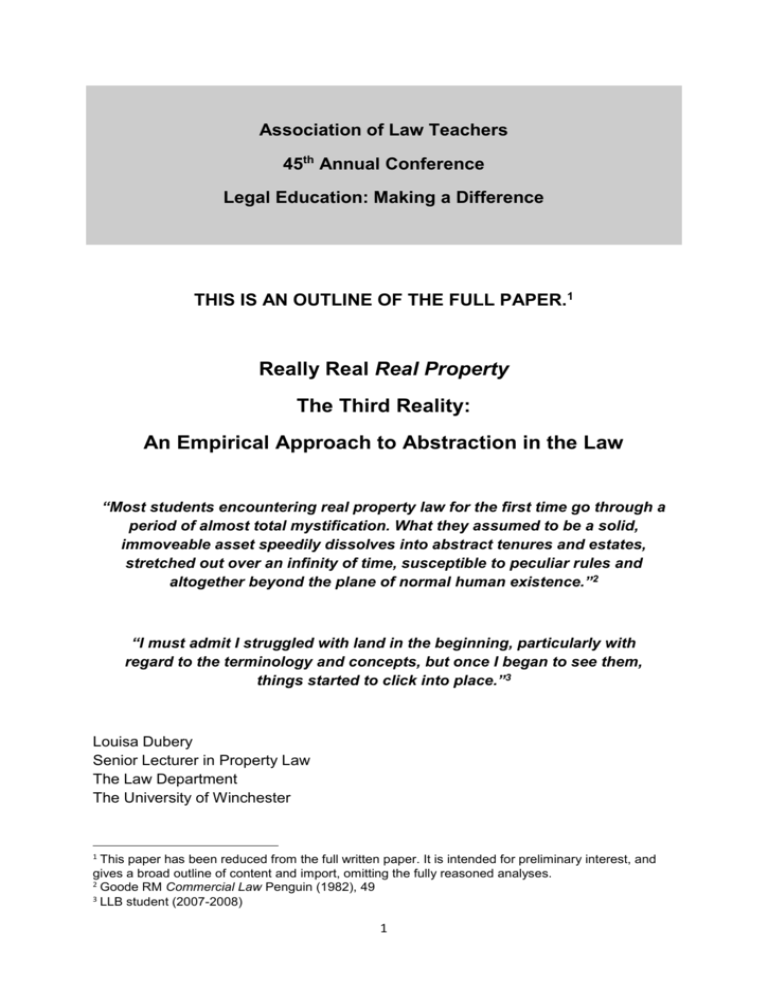
Association of Law Teachers 45th Annual Conference Legal Education: Making a Difference THIS IS AN OUTLINE OF THE FULL PAPER.1 Really Real Real Property The Third Reality: An Empirical Approach to Abstraction in the Law “Most students encountering real property law for the first time go through a period of almost total mystification. What they assumed to be a solid, immoveable asset speedily dissolves into abstract tenures and estates, stretched out over an infinity of time, susceptible to peculiar rules and altogether beyond the plane of normal human existence.”2 “I must admit I struggled with land in the beginning, particularly with regard to the terminology and concepts, but once I began to see them, things started to click into place.”3 Louisa Dubery Senior Lecturer in Property Law The Law Department The University of Winchester 1 This paper has been reduced from the full written paper. It is intended for preliminary interest, and gives a broad outline of content and import, omitting the fully reasoned analyses. 2 Goode RM Commercial Law Penguin (1982), 49 3 LLB student (2007-2008) 1 1. Introduction: The subject and its wider relevance. Recent student texts suggest that real property`s notorious reputation as a difficult and troublesome subject is diminished by recent legislative reform. First, this places a confidence in statutory intervention belied by the history of real property law and second, it risks defining and devaluing property study by its statutory boundaries. Most importantly, however, it omits from consideration the extent to which problems with property study reside not with the law itself but within the nature of the English idea of real property. Legislative intervention alone will not transform the “ugly duckling.” 4 This research explores a new approach to the property problem, based on the notion of experiential connection. Experiential connection refers to the link that exists in a subject between its legal reality and its lay reality; specifically, any general consciousness of the subject that a student has before he comes to the legal study of it. The paper examines whether experiential connection can provide the key to property understanding and if so, how it can be developed into a model of property pedagogy that is specifically aimed to overcome certain intractable characteristics in the concept of property. These characteristics were identified in previous foundational research and shown to have a significant adverse effect on the study of property law.5 Whilst this paper is located in a specific legal context, the focus on the generic notion of experiential connection means it is concerned with the wider question of how students engage with abstract subject matter. This paper explores a hypothesis relative to the property problem. If the hypothesis has validity, and if it is later established as a general cultural, social or cognitive phenomenon, then property could simply become the context in which it is applied. 2. Why this research? A summary of the foundational and continuing research process. Research into experiential connection as a model for revisiting the pedagogy of real property is part of a continuing research project. It originated in a foundational study that aimed to identify and understand real property law`s reputation, typically described as “the horror story of a law degree.”6 This was important because the law itself is not necessarily difficult; in fact it has an internal structure that facilitates study and proprietary relationships offer greater conceptual and normative certainty than personal ones. 4 Green K `There was Once an Ugly Duckling in Land Law 1985` (1985) 19 Law Teacher 65. Land law is described as “the ugly duckling of a law degree.” 5 Dubery L `Restoring Real Property` (2008) 2 Web JCLI 6 Arden `Review of Cheshire`s Modern Law of Real Property (12th ed.)` 126 NLJ 933, 1 2 This section describes the background to this research: the foundational study and three subsequent projects that resulted in the present hypothesis. These projects are very briefly summarised below. 2.1 Restoring Real Property: An Enquiry Into the Property Condition of Higher Education in England and Wales The research began with an empirical study to ascertain particular facts about property courses. It sought to discover how courses were run, by whom and their content. It was particularly concerned with discovering if real property`s reputation existed, and what it meant. The outcome suggested that the difficulties may lie more with the distinctive attributes of English property, the fact that it exists as an idea, than with the law itself. It was not evident that nay courses addressed this directly. 2.2 The Narrative of Pedagogic Property Discourse If it is correct that the problem resides in the idea of property, the next step was to examine how property`s existence as an idea has connected to pedagogy in a broader context. This study was a textual examination on property discourse based mainly on each of the three dominant texts in each generation, taking the watershed of the modern period to be the 1925 legislation. 7 In particular the enquiry sought to discover if there is a relationship between the idea of property and the normative framework in which property writing takes place? If so, might these norms have influenced the way pedagogy has developed? If so, how? 2.3 Is There a Black Hole in Blackacre? The study of the textbook tradition suggested that because of the nature of English property, the black letter method in academia has had a particularly important influence.8 Although there is extensive literature reacting against this approach to property law, 9 the questionnaire suggested that a rule based approach is prevalent. This part of the research process comprised experience as part of a team at a university which delivered a predominantly rule based course, and reflection on the teaching and learning experience, intellectual enrichment and progression. 7 Cheshire GC Modern Law of Property (Butterworths, London,1925); Megarry RE A Manual of Real Property (Sweet and Maxwell, London, 1946); and Gray K Elements (Butterworths, London, 1987) 8 An example to which the paper refers is Professor Rudden`s creation of a schematic representation of Professor Lawson`s “world of pure ideas.” There is considerable intellectual rigour in this approach, although Professor Rudden acknowledges it is “not attractive reading.” Rudden B `Notes Towards a Grammar of Property` (1980) The Conveyancer and Property Lawyer 325. 9 A good example of the arguments is to be found in Harwood M `Is There Coherence or Logic in Blackacre? A Plea to the Guardians of the Core` (1989) 13 Law Teacher 45 3 2.4 Focusing on Property. Rule based approaches tend to be characterised by autonomy in delivery as well as in law, so this study sought to explore a converse approach. It aimed to establish a working property pedagogy which evolved as much as possible through student perspectives. It comprised focus groups of undergraduate and graduate property students held in alternate weeks over one academic year. The objective was to understand the student experience of learning property law, to discuss themes and to formulate methods for the implementation of ideas which, following implementation, were revised in feedback discussions. 3. Explaining the theme: “Experiential connection” The need to address abstraction, and the concrete approach preferred by the students, led to an interest in the idea of experiential connection as the basis for revisiting property pedagogy. Experiential connection may be described as the link between the student`s ordinary life experience and the subject as it exists at law; the awareness, for example, that a contract is an agreement. Such lay perceptions are rapidly subsumed by legal study, but the idea of experiential connection itself remains critically important and deserves further examination. It is highly effective in facilitating accessibility and engagement, and therefore important in an area of law whose reputation affirms the enduring elusiveness of those qualities. However, experiential connection from absent in real property.10 It is atypical among legal concepts in that its legal idea bears no relation whatsoever to its lay idea. The lay reality is a physical asset capable of ownership. The legal reality is an abstract relationship existing in a fourth dimension defined by heritability.11 These are the two realities of property. 4. The research question This section explains why the lack of experiential connection in real property should make it central in any pedagogic determinations about property. The research asks: “Can creating an experiential connection provide the key to real property understanding?” Responses in the questionnaire on the condition of property reinforced this point eg “What most people think they know about the law is wrong”; “contextually remote from students` lives.” 11 The classic definition is Professor Lawson`s: “[Real property law] is logical and orderly, its concepts are perfectly defined, and they stand in well recognised relations to one another....So extreme are these various characteristics that they make this part of the law something more logical and more abstract than anything that to my knowledge can be found in any other law in the world....” Lawson FH The Rational Strength of English Law (The Hamlyn Lectures 3rd ser., Littleton: Colombia, FB Rothman, 1988) 33 10 4 Creating an experiential connection refers to the idea of developing a third reality that connects the legal and lay realities: the building of a pedagogic landscape in which to locate learning. Its objective is to discover whether and how students are facilitated in the understanding abstract legal ideas through the lay notion of physical representations, widely interpreted. It incorporates evaluation of different physical representations as the basis for their more specific development and the ways in which this can be used to encourage diverse skills. The section then goes on to explain how this is an innovative approach capable of exploiting the richness of the property phenomenon to benefit all aspects of the learning experience. 5. Critique of previous approaches to abstraction in property scholarship This section summarises the main ways in which the dereification problem has been addressed in property scholarship, and their defects. Examples are the moral,12 sociological13 or policy14 approaches. 6. The primary determinants: A property philosophy and the pedagogic goals Problems arising from previous attempts at dereification highlight the need to ground property discourse in a rigorous methodological and epistemological philosophy. 15 This paper establishes an orthodox model of enquiry; it draws only on ideas and institutions that are particular to property, and excludes factors that exist beyond specific property reasoning. This study is therefore concerned with the attributes that have characterised English property for eight centuries, and it aims to achieve outcomes that exploits the richness of the property phenomenon. This recognises that recent judicial discourse has increasingly been concerned with property thinking, with property as an idea.16 7. The pedagogic landscape and the continuing evaluation of its features This section describes the different ways in which third reality has been built, and evaluates student feedback. It asks question such as “Are some representative Eg “[A] more explicit moral basis for the subject than is usually given.” Warrington R `Land Law and Legal Education: Is there Any Justice or Morality in Blackacre?` (1984) 18 Law Teacher 77 13 Gray K and Symes DP Real Property and Real People: Principles of Land Law (Butterworths London 1981) 14 The “land law as applied social policy....as applied economic policy”. McAuslan P “The Ideology of Land Law Teaching` (1977) 2 No 4 University of Warwick Working Papers, 5,8. 15 Harris PJ and Buckle JD (1976) `Philosophies of the Law and the Law Teacher: A Re-Appraisal of the Problems of Teaching Law` 10 Law Teacher 1 16 Examples of cases examining the legitimate parameters of relative proprietary entitlement are Cobbe v Yeoman Row`s Management [2008] UKHL 55, [2008] 1 WLR 1752; Thorner v Major [2009] UKHL 18; [2009] 1 WLR 776. 12 5 forms means more effective for learning than others?”, “What skills does this approach to learning encourage?”, “How can different representative forms be used to develop different skills?”, “To what extent does efficacy of one form have universality among different students?”, “What are the problems with this approach?”, “Which forms do not work and why?” 8. Outcomes, Cracks and Proposals This section explains the findings, their defects and proposes how the research could be improved and developed. 6
